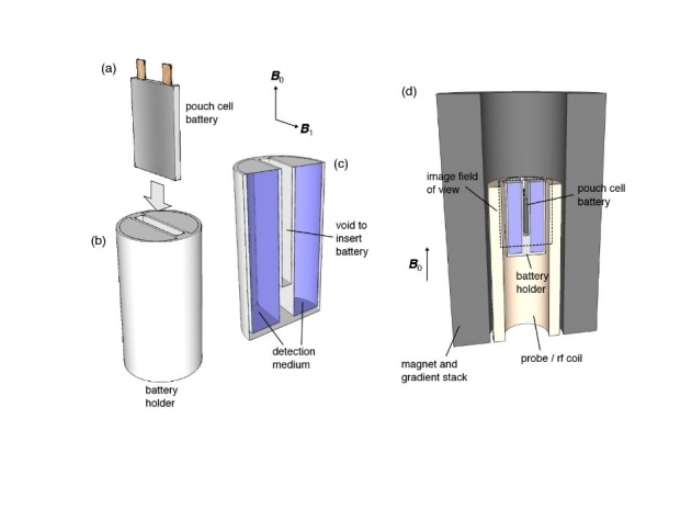May 4 2018
A team of chemists has formulated an MRI-based method that can swiftly diagnose what affects certain types of batteries - from establishing how much charge is present to detecting internal flaws - without having to open them.
 A team of chemists has developed an MRI-based technique that can quickly diagnose what ails certain types of batteries—from determining how much charge remains to detecting internal defects—without opening them up. Above is an illustration of measurement setup showing the cell and the holder with the detection medium (water in this case), and (d) showing both inserted within the magnet bore of an NMR magnet. (Image credit: Andrew Ilott and Alexej Jerschow)
A team of chemists has developed an MRI-based technique that can quickly diagnose what ails certain types of batteries—from determining how much charge remains to detecting internal defects—without opening them up. Above is an illustration of measurement setup showing the cell and the holder with the detection medium (water in this case), and (d) showing both inserted within the magnet bore of an NMR magnet. (Image credit: Andrew Ilott and Alexej Jerschow)
“The use of alternative energy and electrically powered vehicles will further increase the demand for better and safer batteries,” observes Alexej Jerschow, a professor in New York University’s Department of Chemistry, who led the research team. “However, there are currently only a very limited set of tools available to diagnose a battery’s health without destroying the battery—our non-invasive technique offers a faster and more expansive method for making these assessments.”
The study, reported in the Nature Communications journal, also included Andrew Ilott, an NYU post-doctoral fellow at the time of the research and currently a research investigator at Bristol-Myers Squibb; Mohaddese Mohammadi, an NYU doctoral candidate; and Christopher Schauerman and Matthew Ganter, research scientists at the Rochester Institute of Technology.
“Ensuring cell quality and safety is paramount to the manufacturing process that can save companies significant cost and prevent catastrophic cell failures from occurring,” says Ganter, co-director of the RIT Battery Prototyping Center.
“This work not only supports the battery industry as a whole but also the growing energy storage ecosystem in New York,” adds Christopher Schauerman, co-director of the RIT Battery Prototyping Center.
The study specifically examined the rechargeable Lithium-ion (Li-ion) batteries, which are used in laptops, cell phones, and other electronics.
In particular, rechargeable batteries are at the center of new technologies, including storage for renewable energy sources or electric cars.
However, latest glitches in handheld devices and electric vehicles have underlined the difficulties in designing batteries for these innovative technologies. Furthermore, engineers time and again cannot establish the type of defects or even impending battery failures without dismantling the device, which usually results in its damage.
Generally, magnetic resonance (MR) techniques provide the ability to measure minute changes in magnetic field maps and, consequently, create an image of what lies within a structure—for instance, magnetic resonance imaging (MRI) can create images of the human body’s organs in a non-invasive manner.
In their Nature Communications research, the researchers made use of a process similar to MRI. Here, they measured minute magnetic field variations surrounding the battery’s electrochemical cells.
In their experiments, they studied Li-ion batteries in various states—many levels of charge (i.e., battery life) and conditions (i.e., a few damaged and others not). Such cells were put together by collaborators at RIT’s Battery Prototyping Center. Using these cells, the NYU team was able to match magnetic field variations surrounding the batteries to different internal conditions, exposing the state of charge and specific defects. These included missing and bent electrodes as well as tiny foreign objects in the cell, which are imperfections that can happen during the regular manufacturing process.
With future enhancements to this method, it could provide a powerful means of predicting battery failures and battery lifetimes as well as facilitate the development of next-generation high-performance, high-capacity, and long-lasting or fast-charging batteries.
Alexej Jerschow
The study was supported by a grant from the National Science Foundation (CHE-1412064) and NYU’s Technology Acceleration and Commercialization award.
Jerschow and his NYU colleagues have also lately received a $150,000 grant from PowerBridgeNY, a New York State-backed accelerator that aids entrepreneurs and scientists to commercialize clean technologies, to continue to improve this and related methods.